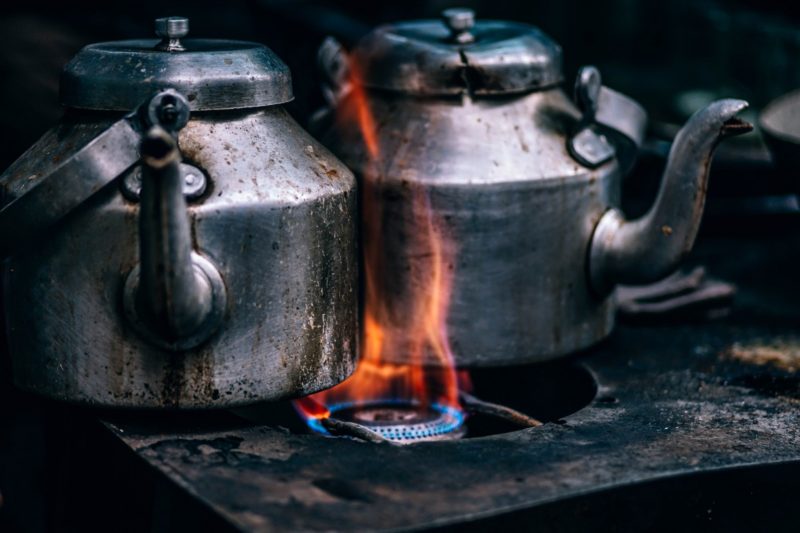How to keep grease from splattering on stove? As a result of the buildup in the cracks, your stove, walls, countertops, and cabinets will ultimately get caked with grime. In addition, if grease builds up on surfaces, it will have a bad taste in your mouth and make your house smell bad.
The longer you let grease build up, the less time it will take to clean it up. You can deal with oil splatter without making significant alterations to your cooking methods by following a few easy measures that we will be discussing for the rest of this post.

Tips To Keep Grease From Splattering On Stove
How to keep grease from splattering on stove? We can’t avoid accidents, but there are ways to keep your stove clean, and that is by learning how to control and remove oil from several surfaces by using the things listed below. Keeping the following tips in mind can greatly help in preventing grease, thereby making stove cleanup easier.
Tip #1. Reducing water
Using your stovetop grill, turn the water down to the lowest level to prevent burns and splatters. Oil and water, as the old saying goes, do not mix. That is also true when it comes to frying meals. Before adding any oil, be sure that the pan is dry on the inside.
Adding water and oil to a hot pan can cause an explosion and oil to spray anywhere it is placed. You may speed up the drying process by doing it on the stovetop over medium heat. The water will evaporate due to the high temperature of the heated pan. Also, ensure that the food is completely dry before frying to prevent sticking to the pan.
Finally, before wiping dry, run frozen food underwater to dissolve ice crystals.
Tip #2. Using bigger pans
The less spatter on your burner, the better when cooking a large surface area. Reduce spatter by cooking in a sauté pan. A sauté pan can retain more liquid because of the straight edges. In other words, there’s less chance of oil splashing out of the pan. If you’re shallow frying your dinner, the tall sides will come in handy. To make meatballs in a half-inch of oil or to braise chicken thighs in white wine, you’ll need a tablespoon of oil.
When you cook in a sauté pan rather than a skillet, the amount of food you can toss at one time is restricted. In addition, food slides easily up the sides of a pan due to the sloping edges. Another problem is that the sauce spoils quickly. Others choose a skillet’s slanted surface over a sauté pan’s flat surface because it promotes faster moisture evaporation. As a result, your meat will be turn out well.
Tip #3. Cover your pan
Many kitchen appliances, like the Instant Pot, are set up just to be forgotten. Conversely, using an open-top pot or pan requires your presence to keep an eye on the oil and prevent splattering. If you’re going to be away from the kitchen for a lengthy amount of time, turn down the heat first.
Using a lid to cover the pan while cooking reduces spatter. Stopping oil in its tracks can be accomplished with the use of a cover. Remove some of the pressure by moving it slightly off-center.
Tip #4. Frying using a splatter barrier
Another tip to reduce splatter on your stove is to keep your stove, counter, and walls clean by installing an anti-splatter screen on your oil burner. Cleaning is much easier because the high walls contain the spatter. You can pick from three to five different perspectives. Then, when you’re through cooking, fold it flat and put it somewhere safe and convenient. Because of the non-stick surface’s smoothness, cleaning will be a breeze.
For extended periods, this silicone can withstand temperatures of up to 450 degrees Fahrenheit. They’re also easy to clean because they’re dishwasher-safe. In addition to preventing spatter, Frywall extends the pan’s sides.
It serves as a convenient disposal point for green vegetables that still need to cook.
Tip #5. Using multi-cooker
One more tip is to use a multi-cooker to reduce spillage. As its name states, this latest appliance can be a slow cooker, electric pot, fryer, steamer, electric pot, and more. It is an all-in-one product! Regardless, you can use it as a pressure cooker to keep your food from spilling. Learn more about this amazing product here: What can a multi-cooker do?
Tip #6. Cleaning the stove
The easiest approach to remove splatters of oil is to clean your stove and other surfaces. An easy method to get oil all over your house is to spray it. Unfortunately, there will always be a few mistakes on your stove, no matter how meticulously you clean it. In addition, unseen food and oil spatter are a common problem.
In a well-lit kitchen, it is easier to notice where crumbs and other food waste have accumulated over time, so most would design their kitchen with enough lighting. On the other hand, while you are cleaning your stove, you might clean the coils too. Here is how to clean a coil stovetop. For more articles, here is one where you can learn how hot a stove can get. That is all!
It’s A Wrap!
How to keep grease from splattering on stove? An oil spatter irritates the nose, disgusts the stomach, and detracts from the stove’s appearance. If you ignore it, it has the potential to alter the color of your walls. As long as you follow the advice above on keeping grease from splattering on the stove, it would help if you had little to no splatter to clean up.
Less oil splatter means a cleaner house and healthier air for you and your family.
